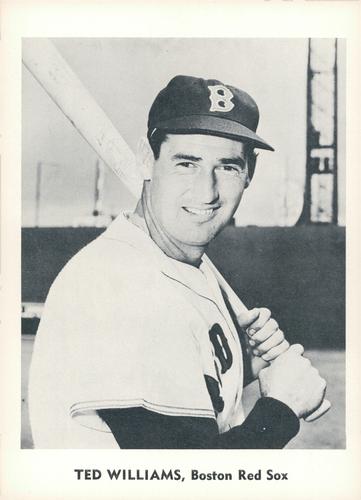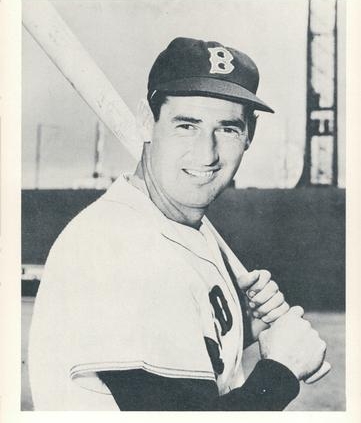September 17, 1960: Ted Williams’ 2-run homer beats a solo shot by Jim Lemon
 This was the next-to-last home run Ted Williams ever hit. It was also the fourth game-winner in a row he had hit off Washington Senators right-hander Pedro Ramos, who was only 25 years old but had given up six home runs to Williams, with the four game-winners tying him (with Virgil Trucks) for first place among pitchers who allowed Williams to win a game with a home run.1 The homers he had hit off Ramos were numbers 388, 409, 418, 430, 482, and this one was number 520. The prior game-winners were September 25, 1956; June 2, 1957; and September 28, 1958.2
This was the next-to-last home run Ted Williams ever hit. It was also the fourth game-winner in a row he had hit off Washington Senators right-hander Pedro Ramos, who was only 25 years old but had given up six home runs to Williams, with the four game-winners tying him (with Virgil Trucks) for first place among pitchers who allowed Williams to win a game with a home run.1 The homers he had hit off Ramos were numbers 388, 409, 418, 430, 482, and this one was number 520. The prior game-winners were September 25, 1956; June 2, 1957; and September 28, 1958.2
The game was a 2-1 win for Boston Red Sox pitcher Billy Muffett, who threw a three-hitter, just as he had on September 6 in New York in Boston’s 7-1 win over the Yankees. The start after that, he had lost a 1-0 game in Chicago. Muffett had spent some time with the St. Louis Cardinals and San Francisco Giants and was acquired from the Giants in late July 1959. He had pitched fewer than seven innings without a decision for San Francisco in 1959. He’d joined the Red Sox from the Triple-A Minneapolis Millers near the end of June 1960 and was 5-3 with a 3.36 ERA coming into this game. In seven of his last eight starts, Muffett had not allowed more than two runs.
Washington manager Cookie Lavagetto had Ramos (11-14) pitching. Ramos had beaten the Red Sox three times earlier in 1960 and had two no-decisions against them, but both of those were also games the Senators won. In six of Ramos’s prior losses, he had allowed three or fewer runs. He threw a very good game on September 17, allowing just five hits and walking no one in the eight innings he worked.
The only batter to get on base in the first inning was Boston center fielder Willie Tasby, and that was because of an error by shortstop Zoilo Versalles. Ted Williams’s grounder forced Tasby at second base.
Muffett walked two in the bottom of the first, but Senators center fielder Lenny Green was caught trying to steal second before the second walk, to Harmon Killebrew, who was left on base at the end of the inning.
In the second, Red Sox third baseman Frank Malzone hit a one-out double to left field but a groundout and popup left him stranded on second. After the first out, Muffett walked another batter, right fielder Bob Allison, but third baseman Reno Bertoia hit into a double play.
Nobody reached base for either team in the third inning.
The 42-year-old left fielder of the Red Sox – Ted Williams – singled to left field leading off the fourth. Vic Wertz, the first baseman, hit into a double play, so catcher Russ Nixon’s double off the right-field wall did not produce a run. In the bottom of the fourth, Killebrew reached on an infield single that had glanced off Muffett’s hip. The next batter, Jim Lemon, hit one hard off Muffett’s shin, but the pitcher picked up the ball and threw Lemon out at first base. Catcher Earl Battey then hit one back to Muffett as well, but one that Muffett handled routinely. Nixon never got past second base.
Ramos retired the Red Sox in order in the top of the fifth. Allison singled to right field for Washington but Bertoia struck out and both Allison and Billy Gardner were out on a strikeout-caught stealing combination.
After five innings, neither team had scored.
That changed in the top of the sixth. Red Sox second baseman Pete Runnels flied out to left field. Willie Tasby lined a sharp single to center. On the fourth pitch he saw, Ted Williams “swung at the next pitch and it went on a line toward the top of the right-field fence – 31 feet high, 355 feet away, and 30 feet in from the foul line. The ball was on the rise until it was about 15 feet from the top of the fence. Then it leveled off and cleared the fence by two or three feet.”3 The Boston Herald report agreed that the ball had barely skimmed the barrier.4 The home run – number 520 of his major-league career, which dated back to 1939 – gave the Red Sox a 2-0 lead.
Wertz struck out and Nixon flied out to center field, ending the half-inning.
Ramos was the first batter for Washington in the bottom of the sixth. He grounded out to shortstop, Don Buddin to Wertz. Versalles grounded out Runnels to Wertz. Lenny Green flied out to Lou Clinton in right field.
In the Red Sox seventh, Ramos got both Malzone and Clinton to fly out to Lemon in left field. Buddin grounded to second base, thrown out Gardner to Killebrew.
Killebrew led off the bottom of the seventh, hitting a “towering fly” to Williams in left field.5 Jim Lemon swung at the first pitch and hit the ball harder to left field, where it went into Griffith Stadium’s visitors bullpen. It was a home run, Lemon’s 38th of the season, giving the Senators their first run. It was a one-run game, 2-1. “Unfortunately,” wrote the Washington Post, “Lemon didn’t have the foresight to have a man on base, the way Williams did.”6 Washington catcher Battey hit the ball on a line to Runnels at second base for the second out. Allison hit a grounder to Malzone at third. The throw to Wertz was on target and the game headed to the eighth inning.
Muffett led off and hit a grounder to Versalles, who threw him out. Runnels flied out to left field Tasby flied out to right field. In eight innings, Ramos had allowed just five hits, two of them to “Old Hoss Williams.”7
All the Senators needed was the one run to tie. Bertoia got a base on balls to lead off the bottom of the eighth, and then manager Lavagetto started to pull out all the stops, putting in three pinch-hitters in a row. First, Julio Becquer hit for Gardner. Actually, Gardner had started the at-bat and bunted foul on two pitches. So Lavagetto pulled him in the middle of the at-bat and sent in Becquer with the count 0-and-2. Becquer hit a grounder that Runnels fielded, falling on it and throwing him out while flat on his stomach, as Bertoia took second.
Ramos was due up with the tying run in scoring position. The next two pinch-hitters both hit left-handed. Faye Throneberry pinch-hit for Ramos. He likewise hit one on the ground to Runnels, and Bertoia went from second base to third as Throneberry was thrown out at first. The third pinch-hitter – for Versalles – was Elmer Valo. He hit a fly ball to center field for the third out.
The new pitcher for the Senators in the ninth was Hal Woodeshick. Billy Consolo took over at second base, where Gardner had been, and Jose Valdivielso took over at shortstop. Ted Williams hit a fly ball that Lemon caught in left field. Vic Wertz popped up to Consolo at second base. Russ Nixon flied out to center field.
There was some defensive shifting for the Red Sox in the bottom of the ninth. Carroll Hardy went to left field, replacing Ted Williams. Runnels moved from second base to play first, with Wertz leaving the game. Marlan Coughtry played second base.
Muffett, still pitching, got successive fly-ball outs to center field by Green and Killebrew. Lemon, who had done the only real damage with his seventh-inning home run, hit a foul popup caught by catcher Russ Nixon, ending the game.
The game took 1 hour and 40 minutes to play. It had attracted 5,264.
The day ended with the Red Sox still in seventh place. The Senators were still in fourth place, but only by a half-game ahead of the fifth-place Cleveland Indians. There were 11 games left on the schedule. Boston ended up seventh. Washington lost 10 of those 11 games and wound up in fifth place.
Ted Williams, by virtue of his sixth-inning home run, had the 110th game-winning home run of his career, one that gave the Red Sox all the runs they needed to hold on and win the game.
Acknowledgments
This article was fact-checked by Bruce Slutsky and copy-edited by Len Levin.
Sources
In addition to the sources cited in the Notes, the author consulted Baseball-Reference.com and Retrosheet.org.
https://www.baseball-reference.com/boxes/WS1/WS1196009170.shtml
https://www.retrosheet.org/boxesetc/1960/B09170WS11960.htm
Notes
1 A “game-winning home run” is defined here as a home run that provides a game’s final margin of victory, giving the winning team at least one more run than the opposing team scored. For example, if a two-run homer increased a team’s lead from 2-1 to 4-1, and they went on to win 4-3, it qualifies as a game-winning home run. (This is different from the definition of “game-winning RBI” in baseball’s official statistics from 1980 through 1988, which counted as “game-winning” the RBI that provided a winning team the lead that it never relinquished.)
2 It was also, as it happens, the eighth home run he had hit on a September 17. See preceding career homers numbers 28, 124, 195, 323,337, 452, and 478. For the full story of each of Ted Williams’s home runs, see Bill Nowlin, 521: The Story of Ted Williams’ Home Runs (Cambridge, Massachusetts: Rounder Books, 2013).
3 Roger Birtwell, “Williams’ Homer Rips Nats, 2-1,” Boston Globe, September 18, 1960: 69.
4 Henry McKenna, “Ted’s 520th Home Run Wins, 2-1,” Boston Herald, September 18, 1960: 59. There is disagreement between newspaper accounts as to whether the count was 2-and-1 or 1-and-2.
5 Birtwell.
6 Bob Addie, “Nats Still 4th Despite 2-1 Defeat,” Washington Post, September 18, 1960: C1.
7 Addie.
Additional Stats
Boston Red Sox 2
Washington Senators 1
Griffith Stadium
Washington, DC
Box Score + PBP:
Corrections? Additions?
If you can help us improve this game story, contact us.


